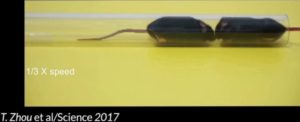Three chambers sociability and social novelty test – This test aims to evaluate animal levels of sociability (preference of an unfamiliar mouse over an object) and preference for social novelty (preference of a novel stranger over a familiar one).The device used in this test consists of three chambers (left, right and central); the central chamber is connected to the others with doors. In the habituation phase, the animal is allowed to explore the device freely for 10 minutes. In the second, sociability phase, a stranger mouse is placed in one of the lateral chambers (inside a specially devised cup with bars). In the social novelty phase another stranger is similarly introduced into the other lateral chamber. During phases 2 and 3, time spent in each chamber, number of approaches to each stranger mouse and their frequency are tracked and recorded.
[This test is applicable to mice only]
Reference:
Nadler JJ, Moy SS, Dold G, Trang D, Simmons N, Perez A, Young NB, Barbaro RP, Piven J, Magnuson TR, Crawley JN (2004) Automated apparatus for quantitation of social approach behaviors in mice. Genes Brain Behav 3(5):303-314
Social interaction in pairs – The aim of this test is to investigate levels of sociability displayed in mutual social exploration of two hitherto unfamiliar animals. The test is performed in a neutral cage. Before the test, each individual animal goes through a 10 min session in the neutral cage alone (habituation to test conditions). After habituation, the two unfamiliar animals are placed together in the neutral cage for 10 min. The time and frequency spent in different kinds of social interactions is measured.
[This test is applicable to rats and mice]
Reference:
Jamain S, Radyushkin K, Hammerschmidt K, Granon S, Boretius S, Varoqueaux F, Ramanantsoa N, Gallego J, Ronnenberg A, Winter D, Frahm J, Fischer J, Bourgeron T, Ehrenreich H, Brose N (2008) Reduced social interaction and ultrasonic communication in a mouse model of monogenic heritable autism. Proc Natl Acad Sci U S A 105(5):1710-1715
Resident intruder test – In this test for aggressive social interaction, same sex mice are first individually housed (for 7 days before testing) as cage resident mice. As the intruder mouse a group caged same sex and age mouse is selected. The intruder is introduced into the cage of the test resident mouse. The observation starts when the resident first sniffs the intruder. The observation stops when the first attack (by either mouse) occurs, or when no attack has occurred by 5 minutes observation.
[This test is applicable to mice only]
Reference:
Koolhaas JM, Coppens CM, de Boer SF, Buwalda B, Meerlo P, Timmermans PJ (2013) The resident-intruder paradigm: A standardized test for aggression, violence and social stress. J Vis Exp(77):e4367
Tube Dominance Test –The test apparatus consists of a 30 cm transparent tube with a 3.5 cm diameter. A day before the test each animal undergoes 4 training trials, 2 minutes each, in which it goes across the entire tube. A day after (the test day), at the beginning of each trial, two animals are introduced into the tube, one from each end and are released simultaneously. A trial is complete when one animal is defeated and has been pushed back until two legs are out of the tube or after 2 minutes if no animal has won till then (Palle et al, 2019). In case no animal has won after 2 minutes, the trial is repeated. Each dyadic encounter consists of one of the test animals with a control mouse for three consecutive trials. The possible grade for each test animal in each test trial is between 0 or 1. Each time an animal wins (pushes its rival out of the tube) it receives a score of 1 in this trial (designated the winner) and the defeated animal receives a score of 0 (loser). Therefore, an animal who is exposed to three trials can receive a total score ranging from 0 (loser in all trials) to 3 (winner in all trials). All the trials are filmed and the videos are stored for subsequent analyses according to alternative scoring methods if these are indicated.
[This test is applicable to mice only]

Science 357(6347):162-168, copyright 2017 Reprinted with permission from the American Association for the Advancement of Science
References:
Zhou T, Zhu H, Fan Z, Wang F, Chen Y, Liang H, Yang Z, Zhang L, Lin L, Zhan Y, Wang Z, Hu H (2017). History of Winning Remodels thalamo-PFC Circuit to Reinforce Social Dominance. Science 357(6347):162-168.
Pallé A, Zorzo C, Luskey VE, McGreevy KR, Fernández S, Trejo JL (2019). Social Dominance Differentially Alters Gene Expression in the Medial Prefrontal Cortex Without Affecting Adult Hippocampal Neurogenesis or Stress and Anxiety-Like Behavior. FASEB Journal 33(6): 6995-7008.
